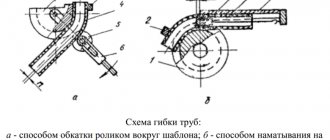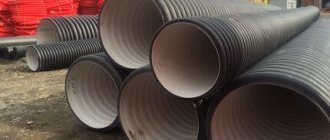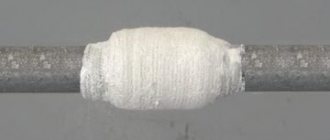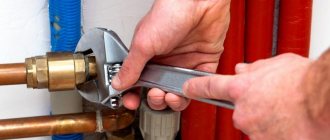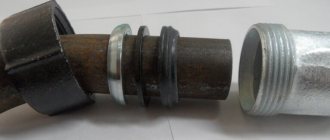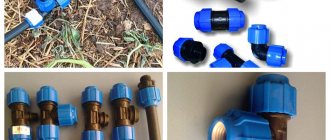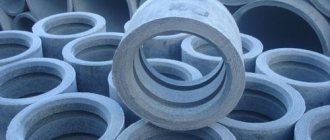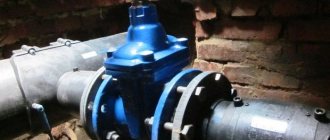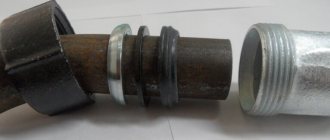Regardless of the types and materials of pipes, shut-off and control valves are a mandatory part of pipelines. It includes the following product groups:
- pass-through and end valves;
- valves;
- safety, control and check valves.
In turn, each type of fittings is divided into many varieties according to the types of locking mechanisms, methods of connection to pipes, body materials and other characteristics.
Currently, pipelines made of steel and polymer, for example HDPE, pipes are in operation, so the question of how to connect a HDPE pipe to a metal tap is quite relevant. There are different ways to solve it. First of all, this is a wide range of pipeline fittings, fittings and fittings, as well as technologies for reliable connection of dissimilar materials.
Pros and cons of connecting a tap to a HDPE pipe
Connecting dissimilar materials in pipelines is a complex engineering problem. Ideally, all pipeline elements should be made of the same material. For steel pipe networks this is not a problem. However, connecting a faucet to a HDPE pipe is more difficult, especially when installing end (water) taps, since the vast majority of the range of this type of pipeline fittings is made of metal and they all have a threaded connection.
Installing a tap on a HDPE pipe has its pros and cons. A positive factor is the availability of a wide range to solve the problem. In addition, the advantages of plastic pipelines include durability, corrosion resistance, etc. Among the disadvantages of connecting pipeline elements from dissimilar materials are:
- the need to resolve issues of their compatibility in terms of wall thickness, operating pressure and other indicators;
- the presence of restrictions on the use of certain joining methods for different materials;
- reduced reliability of connections of dissimilar materials.
In the case where there is no other way to complete the task, all discussions on the pros and cons of connecting to a HDPE pipe can be set aside. The main thing is that it is possible to install a tap on a HDPE pipe, and for this there are many options for resolving the issue.
Connecting polymer pipes by welding
Polymer welding is present in 50% of household communication systems; the joints have improved characteristics, since the process occurs at the molecular level.
The user manuals included in each set of welding equipment describe in detail the technology of how to connect plastic pipes and select the heating time depending on the wall thickness.
Welding with electric couplings is an improved version of the previous method, since the heating and joining process is controlled by a program. The quality of the joint increases, there is no need for fixation. Devices with electrodes are used to supply voltage to the heating elements inside the coupling.
Methods for connecting a tap to a HDPE pipe
All types of connections in plastic pipelines are divided into permanent and detachable. The first of these include:
- welding;
- soldering;
- adhesive connection.
They are used to connect pipes and fittings. Permanent connections for installing pipeline fittings are used extremely rarely.
An example of such a solution is cranes with embedded heaters for sleeve welding. For the installation of taps, gate valves and valves of all types, in 99 cases out of 100, detachable connections are used. These include the following methods:
- on thread;
- on flanges;
- crimp (compression) connections - collet and clamps.
It is impossible to embed a tap into a HDPE pipe directly through threaded connections. For this purpose, there are a variety of fittings for the transition from plastic pipes to metal and vice versa.
Features of polypropylene connection
When assembling individual communication elements made of polypropylene, the following recommendations must be observed:
- The ends of the pipes are made perpendicular to the axis; the parts brought together cannot be skewed. To ensure the alignment of individual parts, guides are used.
- Due to the impossibility of applying threads on polypropylene, joining is performed using threaded fittings, welding or soldering.
- When welding parts of a water pipeline using a soldering iron, it is heated, placed on a stand and only then the pipe is brought in.
- Welding should not be carried out in cold weather, since heating of the material will be insufficient and the quality of the seam will deteriorate.
When carrying out welding work, you must comply with safety requirements and ventilate the room - when heating plastic materials, harmful substances are released.
Which connection method is better?
You should not connect the tap to the HDPE pipe through permanent connections. First of all, this can become a problem when repairing and replacing fittings. Let us remember that faucets, valves and valves have moving parts, the service life of which is much shorter than the pipeline itself. Therefore, when answering the question of how to connect a faucet to a HDPE pipe, a collapsible connection is almost always chosen. The choice of installation method is determined taking into account the following circumstances:
- purpose of the pipeline;
- installation location in terms of access to the work site;
- type of valve - straight through or end;
- pipe diameter, etc.
To install straight-through taps and valves in large-diameter pressure pipelines, flange connections are chosen. They can withstand any load (it is more likely that the pipe will rupture than the flanges will collapse). This connection method requires very precise adjustment of adjacent elements in size. For HDPE pipelines of smaller diameters (up to 110 mm), taps with crimp (compression) couplings are suitable. If you need to put it on a pipe, this installation method will be the best solution.
To install the end (water tap) fittings, the easiest way is to connect the HDPE fitting to a metal tap. Transition fittings from plastic to metal and vice versa can take the form of an angle or a coupling. One of their ends is intended for soldering connections, and the other side is made of metal with external or internal threads - for a regular dismountable threaded connection. Connecting the tap to the HDPE pipe through such adapters is not difficult.
How to make the transition
To connect a HDPE pipe to a pipe made of steel or cast iron, fittings are used, compression at one end and threaded at the other. For installation of large areas, sockets and flanges are used.
For pipes of small diameter, fittings are used according to the principle of a push-in coupling connection: a disassembled part of the fitting - a compression unit - is put on the end of the HDPE pipe, secured by welding and then a threaded element is screwed under the metal pipe.
Flanges are used when it is not possible to use a welded joint. Installation is simple, the choice of parts on the market is huge.
Note! The flange method is the most accessible and cheapest method. Connecting elements are inexpensive, you can choose flanges for any pipe of any diameter.
How to connect a faucet to a HDPE pipe
To install a faucet on a plastic HDPE pipe with your own hands, you need to adhere to a certain action plan that takes into account the technology and rules of work. We will consider the installation option using plastic-to-metal transition fittings. In general, this procedure consists of the following steps:
- selection of the necessary set of tools - it should include a pipe cutter (scissors) to prepare the ends of the pipes for connection, a soldering or welding machine, and keys for installing the faucet itself;
- purchasing fittings of the appropriate types and sizes: for pipes with a vertical outlet these are angles and tees, for pipes with a horizontal outlet, couplings are needed;
- the end of the pipe is cut at a right angle and, if necessary, cleaned of burrs;
- use a soldering iron to heat the connected parts of the pipe and fitting to the required temperature;
- the heated parts are connected without delay and their position is immediately corrected if necessary, which applies to tees and angles; this is not required for couplings;
- a few minutes after soldering the connection, you can install the tap;
- Upon completion of installation, check the tightness and functionality of the tap.
It’s easy to find fairly detailed instructions on the Internet on how to connect a ball valve to a HDPE pipe. However, it is worth noting that the best recommendations for installing taps and other pipeline fittings are given by professionals. Therefore, you should not be misled by the apparent simplicity of this process.
In such work, practical skills that come with experience are especially important. If you do not regularly install pipeline fittings, there is a high risk of errors, which are costly in all senses of the word. Professionals perform many of their actions “on autopilot,” but you don’t have it. Therefore, it would be most reasonable to invite specialists for such work.
Expert advice
Knowledge of how to connect to a metal tap is not enough to install a reliable cold water supply pipeline. You may need expert advice on the following issues:
- what materials are best used to assemble pipelines for various purposes: for example, HDPE pipes are best suited for external sections of water supply networks (lifting water from wells, transporting it to the point of entry into the house, for irrigation systems and meeting household needs);
- how to draw up pipeline laying diagrams indicating the installation locations of shut-off and other types of valves;
- how to select materials and components by quantity, taking into account waste losses and quality for pipeline assembly - it is better to give preference to products from well-known brands or follow the recommendations of specialists;
- what methods to choose for connecting pipeline elements, taking into account specific installation conditions, etc.
Reluctance to listen to the recommendations of specialists can lead to the most negative consequences. At best, you could end up with a leaky faucet, and at worst, you could flood your home with hot or cold water.
Design of detachable pipe connection
This type of fastening of parts can be done in two ways:
- Into the bell . In this case, the narrower end of one pipe is inserted into the extension - the socket - of the other and sealed using special materials. In most cases, it is used in the construction of non-pressure (gravity) sewerage.
- Fitting and flange connection of HDPE pipes - as the name suggests, to ensure this method of fixation, special devices are used: flanges, couplings for HDPE pipes and others.
Problems and errors when connecting a HDPE pipe to a tap
The consequence of a frivolous and unprofessional attitude towards the construction of pipelines in general and the installation of taps in particular are the following problems:
- leaks in pipes;
- insufficient water pressure in the system;
- inconvenience of using taps and the water supply system in general.
When installing fittings and constructing pipelines, such mistakes are most often made :
- incorrect selection of pipes and fittings according to purpose, wall thickness and other parameters;
- selection of materials that do not correspond to the preferred method of connecting pipeline elements;
- improper use of compression joints;
- insufficient heating of the parts being connected by soldering, which can cause serious accidents on the pipeline;
- laying pipes in places with unacceptable load for them: for example, under the roadway and entrances to the house, without proper protective measures.
These errors may not be obvious at first, but they will certainly manifest themselves in the near future in the problems listed above (and not only them).
Some errors can be corrected without much expense, and some of them will require complete reworking of the pipeline sections where they were made. Let us repeat again: if you are not confident in the choice of materials or your abilities as a plumber, contact the experts. Professional services will cost you much less than eliminating the consequences of mistakes.
Features of connecting sewer pipes
When installing and repairing sewer systems, it is often necessary to switch from iron pipes to polypropylene. The connection with cast iron analogues has its own peculiarities due to their design differences.
You need to have special components available:
- seals;
- corrugation;
- cuffs
First of all, you need to purchase various parts. If you cannot find the necessary components, you can even use improvised materials. For example, cut a seal from microporous rubber. A long, narrow strip is placed between adjacent elements to be joined, and this material is compacted using a wide, blunt screwdriver.
Coinage is not used for a number of reasons. It can lead to deformation of plastic pipes and prevent the joints from being sealed. But even after the completion of repair work, there remains a high probability of leaks.
The use of cement mortar will not be a durable solution to the problem. Since different materials have different coefficients of thermal expansion, this difference has a negative impact on the design. As a result, cracks soon appear in the cemented joints and the system loses its integrity.
Connecting a water supply or heating system, where you need to decide how to connect a steel pipe to a polypropylene product, is characterized by the regular appearance of smudges, so an important point in installation is the choice of the joining scheme of two different materials.
